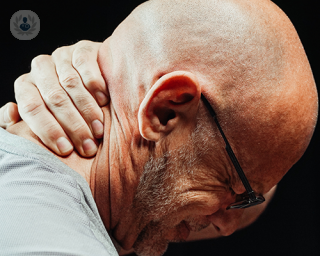What is spinal cord compression?
The spinal cord has nerves that send signals between the brain and the body. Spinal cord compression is when a mass puts pressure on the cord, this mass could either be a tumour or a bone. The spinal cord can become compressed anywhere from the cervical region of the spine (neck), all the way down to the lower spine (lumbar).
What are the symptoms of spinal cord compression?
Symptoms of spinal cord compression depend on the severity of the compression and on the area of the spine that is compressed.
The most common symptoms are:
- Stiffness
- Pain in the back or neck
- Numbness or weakness in the legs, hands and arms
- Loss of sensation in the feet
- Foot drop, weakness in a foot causing a limp
- Motor skills and coordination are also affected
Cauda equina syndrome can develop if the compression occurs in the lumbar region (lower back) and lead to symptoms such as:
- Pain and weakness in the legs
- Loss of bowel or bladder control
- Severe numbness in the back of the legs and inner thighs
How is it diagnosed?
Spinal cord compression can be diagnosed with a medical examination, taking into account a person’s medical history. Tests used for diagnosis include X-rays of the spine, a CT scan or an MRI.
Sometimes a myelogram might be done by injecting dye into the spinal column.
What causes spinal cord compression?
There can be a number of possible causes for spinal cord compression, including:
- Degenerative diseases such as arthritis
- Abnormal spine alignment (scoliosis)
- A ruptured disc
- Injury to the spinal cord
- Cancerous and non-cancerous tumours putting pressure on the spinal cord
- Bleeding disorders, coupled with chiropractic manipulation which causes clots to compress the spinal cord
How can it be prevented?
Maintaining a healthy weight and exercising regularly can help to strengthen the spine and reduce symptoms of spinal cord compression. Learning how to lift heavy items correctly can also prevent injury. Good posture is also essential. Sleeping on a firm mattress and sitting in a chair that supports the back is important.
How is spinal cord compression treated?
Treatment depends on the cause of the compression. Reduced physical activity might be recommended.
Treatment can involve:
- Taking anti-inflammatories to reduce pain and decrease swelling
- Epidural steroid injections into the spine
- Physical therapy to strengthen abdominal muscles and leg muscles to improve symptoms
- Applying heat packs or ice for pain and swelling relief
- Alternative treatment such as acupuncture and chiropractic care
- Chemotherapy or radiation therapy might be prescribed if the cause of compression is a tumour
- Surgery is required when conservative treatments haven’t been successful
What specialist should I see?
An orthopaedic surgeon treats spinal cord compression.
Spinal cord compression
What is spinal cord compression?
The spinal cord has nerves that send signals between the brain and the body. Spinal cord compression is when a mass puts pressure on the cord, this mass could either be a tumour or a bone. The spinal cord can become compressed anywhere from the cervical region of the spine (neck), all the way down to the lower spine (lumbar).
What are the symptoms of spinal cord compression?
Symptoms of spinal cord compression depend on the severity of the compression and on the area of the spine that is compressed.
The most common symptoms are:
- Stiffness
- Pain in the back or neck
- Numbness or weakness in the legs, hands and arms
- Loss of sensation in the feet
- Foot drop, weakness in a foot causing a limp
- Motor skills and coordination are also affected
Cauda equina syndrome can develop if the compression occurs in the lumbar region (lower back) and lead to symptoms such as:
- Pain and weakness in the legs
- Loss of bowel or bladder control
- Severe numbness in the back of the legs and inner thighs
How is it diagnosed?
Spinal cord compression can be diagnosed with a medical examination, taking into account a person’s medical history. Tests used for diagnosis include X-rays of the spine, a CT scan or an MRI.
Sometimes a myelogram might be done by injecting dye into the spinal column.
What causes spinal cord compression?
There can be a number of possible causes for spinal cord compression, including:
- Degenerative diseases such as arthritis
- Abnormal spine alignment (scoliosis)
- A ruptured disc
- Injury to the spinal cord
- Cancerous and non-cancerous tumours putting pressure on the spinal cord
- Bleeding disorders, coupled with chiropractic manipulation which causes clots to compress the spinal cord
How can it be prevented?
Maintaining a healthy weight and exercising regularly can help to strengthen the spine and reduce symptoms of spinal cord compression. Learning how to lift heavy items correctly can also prevent injury. Good posture is also essential. Sleeping on a firm mattress and sitting in a chair that supports the back is important.
How is spinal cord compression treated?
Treatment depends on the cause of the compression. Reduced physical activity might be recommended.
Treatment can involve:
- Taking anti-inflammatories to reduce pain and decrease swelling
- Epidural steroid injections into the spine
- Physical therapy to strengthen abdominal muscles and leg muscles to improve symptoms
- Applying heat packs or ice for pain and swelling relief
- Alternative treatment such as acupuncture and chiropractic care
- Chemotherapy or radiation therapy might be prescribed if the cause of compression is a tumour
- Surgery is required when conservative treatments haven’t been successful
What specialist should I see?
An orthopaedic surgeon treats spinal cord compression.


What is cervical myelopathy? Causes, diagnosis, and treatment
Mr Rohit Shetty
2024-12-23
Cervical myelopathy is a serious condition that requires early diagnosis and appropriate treatment to manage symptoms and prevent permanent neurological damage. Mr Rohit Shetty, renowned consultant orthopaedic and spinal surgeon, provides an expert insight into the condition. Mostrare di più
Medici esperti in
-
Mr Rath Sundaram
TraumatologiaEsperto in:
- Spondilolistesi o Olistesi
- Chirurgia spinale
- Stenosi del canale
- Sciatica
- Dolore alla spalla
-
Mr Alex Torrie
TraumatologiaEsperto in:
- Chirurgia spinale
- Spondilolistesi o Olistesi
- Sciatica
- Discectomia
- Chirurgia della colonna lombare
-
Mr Panos Liantis
TraumatologiaEsperto in:
- Lombalgia
- Dolore cervicale
- Discopatia (protrusione discale)
- Scoliosi
- Chirurgia della colonna mini invasiva
-
Miss Hui-Ling Kerr
TraumatologiaEsperto in:
- Sciatica
- Spondilolistesi o Olistesi
- Chirurgia spinale
- Dolore alla spalla
- Dolore cervicale
-
Mr Manish Desai
TraumatologiaEsperto in:
- Osteoporosi
- Osteoporosi della colonna vertebrale
- Neuropatia periferica
- Malattie neuromuscolari
- Politrauma
- Visualizzare tutti

Cleveland Clinic London Hospital
Cleveland Clinic London Hospital
33 Grosvenor Place
No existe teléfono en el centro.
Se utilizzi questo numero di Top Doctors autorizzi al trattamento dei dati a fini statistici e commerciali. Per maggiori informazioni, leggi la nostra l’informativa sulla privacy
Top Doctors

London Bridge Hospital - part of HCA Healthcare
London Bridge Hospital - part of HCA Healthcare
27 Tooley St
No existe teléfono en el centro.
Se utilizzi questo numero di Top Doctors autorizzi al trattamento dei dati a fini statistici e commerciali. Per maggiori informazioni, leggi la nostra l’informativa sulla privacy
Top Doctors

Cleveland Clinic Portland Place Outpatient Centre
Cleveland Clinic Portland Place Outpatient Centre
24 Portland Place, W1B 1LU
No existe teléfono en el centro.
Se utilizzi questo numero di Top Doctors autorizzi al trattamento dei dati a fini statistici e commerciali. Per maggiori informazioni, leggi la nostra l’informativa sulla privacy
Top Doctors
-
Cleveland Clinic London Hospital
33 Grosvenor Place, Central LondonEsperto in:
- Cardiologia
- Chirurgia del colon-retto
- Chirurgia ad accesso minimo (chirurgia del buco della serratura)
- Chirurgia della cistifellea
- Diagnostica per immagini
- Ecografía
-
London Bridge Hospital - part of HCA Healthcare
27 Tooley St, Central LondonEsperto in:
- 24 ore al giorno
- Cardiologia
- Chirurgia ad accesso minimo (chirurgia del buco della serratura)
- Chirurgia ortopedica
- Malattia cardiovascolare
- Gastroenterologia
-
Cleveland Clinic Portland Place Outpatient Centre
24 Portland Place, W1B 1LU, Central LondonEsperto in:
- Diagnosi del cancro
- Diagnostica
- La salute delle donne
- Medicina dello sport
- Medicina di famiglia
- Controllo medico
- Visualizzare tutti







